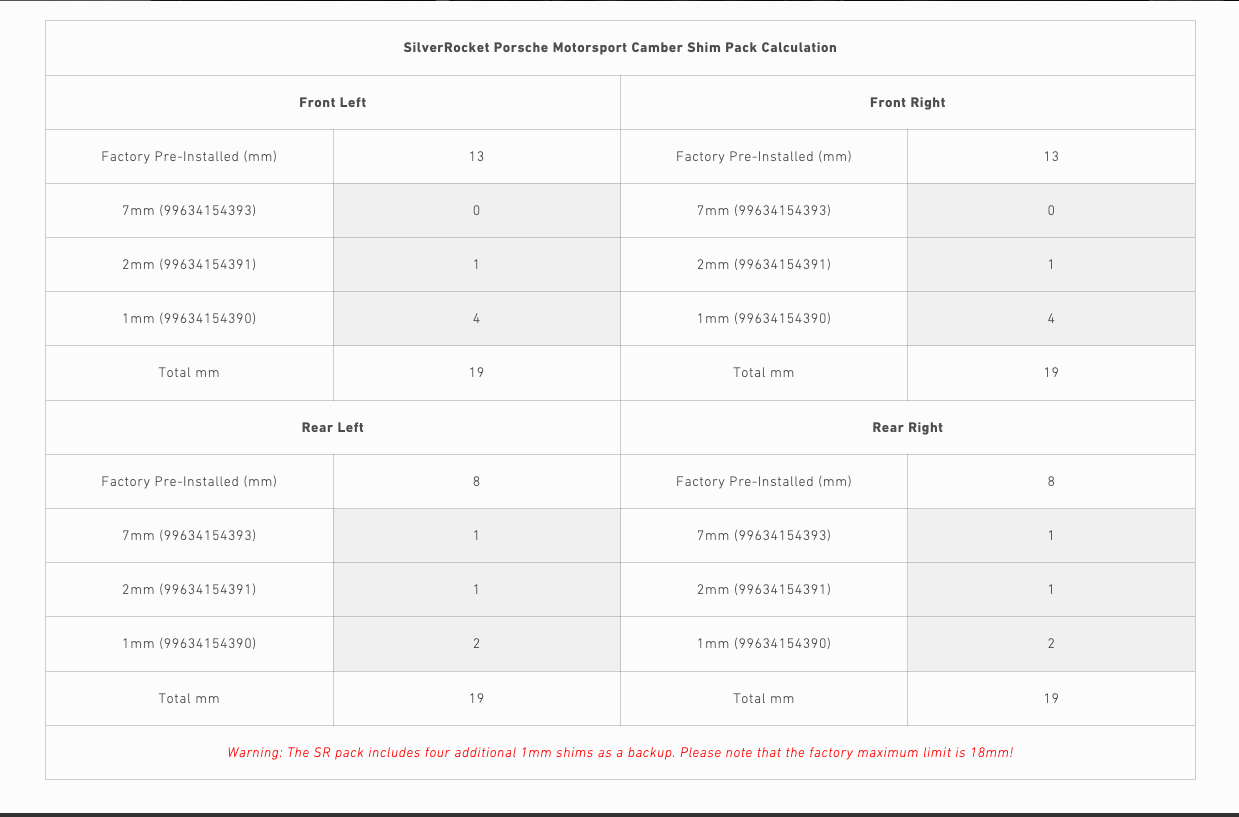Enhance Your Shopify Store with Custom Complex Tables: A Comprehensive Guide

Introduction: Displaying detailed information in a structured format is crucial for an optimal user experience in e-commerce. Complex tables allow merchants to present data like product specifications, pricing, and comparisons clearly and efficiently. This guide explores methods to integrate and customize complex tables within your Shopify store.
<div class="page-width">
<style>
table {
width: 100%;
border-collapse: collapse;
margin-bottom: 1em;
}
th, td {
border: 1px solid #ddd;
padding: 8px;
text-align: center;
}
th {
font-weight: bold;
}
.shaded-row{
background-color: #f2f2f2; /* Light gray shading */
}
.warning {
color: red;
font-style: italic;
padding-top: 10px;
}
</style>
<table>
<thead>
<tr>
<th colspan="4">SilverRocket Porsche Motorsport Camber Shim Pack Calculation</th>
</tr>
</thead>
<tbody>
<tr>
<td colspan="2"><strong>Front Left</strong></td>
<td colspan="2"><strong>Front Right</strong></td>
</tr>
<tr>
<td>Factory Pre-Installed (mm)</td>
<td>13</td>
<td>Factory Pre-Installed (mm)</td>
<td>13</td>
</tr>
<tr>
<td>7mm (99634154393)</td>
<td class="shaded-row">0</td>
<td>7mm (99634154393)</td>
<td class="shaded-row">0</td>
</tr>
<tr>
<td>2mm (99634154391)</td>
<td class="shaded-row">1</td>
<td>2mm (99634154391)</td>
<td class="shaded-row">1</td>
</tr>
<tr>
<td>1mm (99634154390)</td>
<td class="shaded-row">4</td>
<td>1mm (99634154390)</td>
<td class="shaded-row">4</td>
</tr>
<tr>
<td>Total mm</td>
<td>19</td>
<td>Total mm</td>
<td>19</td>
</tr>
<tr>
<td colspan="2"><strong>Rear Left</strong></td>
<td colspan="2"><strong>Rear Right</strong></td>
</tr>
<tr>
<td>Factory Pre-Installed (mm)</td>
<td>8</td>
<td>Factory Pre-Installed (mm)</td>
<td>8</td>
</tr>
<tr>
<td>7mm (99634154393)</td>
<td class="shaded-row">1</td>
<td>7mm (99634154393)</td>
<td class="shaded-row">1</td>
</tr>
<tr>
<td>2mm (99634154391)</td>
<td class="shaded-row">1</td>
<td>2mm (99634154391)</td>
<td class="shaded-row">1</td>
</tr>
<tr>
<td>1mm (99634154390)</td>
<td class="shaded-row">2</td>
<td>1mm (99634154390)</td>
<td class="shaded-row">2</td>
</tr>
<tr>
<td>Total mm</td>
<td>19</td>
<td>Total mm</td>
<td>19</td>
</tr>
<tr>
<td colspan="4" class="warning">Warning: The SR pack includes four additional 1mm shims as a backup. Please note that the factory maximum limit is 18mm!</td>
</tr>
</tbody>
</table>
</div>Methods to Implement Complex Tables in Shopify:
Using Shopify's Rich Text Editor:
Shopify's Rich Text Editor enables basic table creation within product descriptions, pages, or blog posts.
Steps:
Navigate to the desired section (e.g., product description) in your Shopify admin.
Use the editor to insert a table and input your data.
Limitations: This method offers limited customization and may not support advanced table features.
Embedding Custom HTML Tables:
For greater control over table design and functionality, embedding custom HTML allows for advanced customization.
Steps:
Access the HTML editor in the Shopify admin where you want to insert the table.
Paste your custom HTML code for the table.
Apply CSS styling to achieve the desired appearance.
Considerations: Ensure that custom code is responsive and aligns with your store's theme.
Utilizing Shopify Apps:
Several apps facilitate the creation and management of complex tables without manual coding.
Examples:
Table Master – Excel to Table: Allows merchants to create custom tables from Excel files and embed them into various pages.
TablePress – Data Tables: Enables the creation, import, and embedding of data tables within the store.
Benefits: These apps offer user-friendly interfaces and additional functionalities like sorting and filtering.
Best Practices:
Responsive Design: Ensure tables are mobile-friendly to maintain usability across devices.
Consistent Styling: Align table designs with your store's overall aesthetic for a cohesive look.
Conclusion: Integrating complex tables into your Shopify store can significantly improve the presentation of detailed information, thereby enhancing the user experience. By employing methods such as Shopify's Rich Text Editor, custom HTML embedding, or specialized apps, merchants can effectively display intricate data in an organized manner.
For any issues or customization needs, feel free to reach out to us at 📧 tentech.ai.2023@gmail.com.